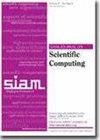A New Thermodynamically Compatible Finite Volume Scheme for Lagrangian Gas Dynamics
IF 2.6
2区 数学
Q1 MATHEMATICS, APPLIED
引用次数: 0
Abstract
SIAM Journal on Scientific Computing, Volume 46, Issue 4, Page A2224-A2247, August 2024.Abstract. The equations of Lagrangian gas dynamics fall into the larger class of overdetermined hyperbolic and thermodynamically compatible (HTC) systems of partial differential equations. They satisfy an entropy inequality (second principle of thermodynamics) and conserve total energy (first principle of thermodynamics). The aim of this work is to construct a novel thermodynamically compatible cell-centered Lagrangian finite volume scheme on unstructured meshes. Unlike in existing schemes, we choose to directly discretize the entropy inequality, hence obtaining total energy conservation as a consequence of the new thermodynamically compatible discretization of the other equations. First, the governing equations are written in fluctuation form. Next, the noncompatible centered numerical fluxes are corrected according to the approach recently introduced by Abgrall et al. using a scalar correction factor that is defined at the nodes of the grid. This perfectly fits into the formalism of nodal solvers which is typically adopted in cell-centered Lagrangian finite volume methods. Semidiscrete entropy conservative and entropy stable Lagrangian schemes are devised, and they are adequately blended together via a convex combination based on either a priori or a posteriori detectors of discontinuous solutions. The nonlinear stability in the energy norm is rigorously demonstrated, and the new schemes are provably positivity preserving for density and pressure. Furthermore, they exhibit zero numerical diffusion for isentropic flows while still being nonlinearly stable. The new schemes are tested against classical benchmarks for Lagrangian hydrodynamics, assessing their convergence and robustness and comparing their numerical dissipation with classical Lagrangian finite volume methods.
用于拉格朗日气体动力学的新型热力学兼容有限体积方案
SIAM 科学计算期刊》,第 46 卷第 4 期,第 A2224-A2247 页,2024 年 8 月。 摘要拉格朗日气体动力学方程属于超定双曲与热力学相容(HTC)偏微分方程的大类。它们满足熵不等式(热力学第二原理)和总能量守恒(热力学第一原理)。这项工作的目的是在非结构网格上构建一种新型热力学兼容的以单元为中心的拉格朗日有限体积方案。与现有方案不同,我们选择直接对熵不等式进行离散化,从而通过对其他方程进行新的热力学兼容离散化来获得总能量守恒。首先,以波动形式写出控制方程。然后,根据 Abgrall 等人最近提出的方法,使用网格节点上定义的标量校正因子对不兼容的中心数值通量进行校正。这种方法完全符合节点求解器的形式,而节点求解器通常用于以单元为中心的拉格朗日有限体积方法。我们设计了半离散的熵保守和熵稳定拉格朗日方案,并根据不连续解的先验或后验检测器,通过凸组合将它们充分融合在一起。能量规范中的非线性稳定性得到了严格证明,而且新方案对于密度和压力具有证明的正保性。此外,它们在保持非线性稳定性的同时,还表现出等熵流的零数值扩散。新方案根据经典的拉格朗日流体力学基准进行了测试,评估了其收敛性和鲁棒性,并将其数值耗散与经典的拉格朗日有限体积方法进行了比较。
本文章由计算机程序翻译,如有差异,请以英文原文为准。
求助全文
约1分钟内获得全文
求助全文
来源期刊
CiteScore
5.50
自引率
3.20%
发文量
209
审稿时长
1 months
期刊介绍:
The purpose of SIAM Journal on Scientific Computing (SISC) is to advance computational methods for solving scientific and engineering problems.
SISC papers are classified into three categories:
1. Methods and Algorithms for Scientific Computing: Papers in this category may include theoretical analysis, provided that the relevance to applications in science and engineering is demonstrated. They should contain meaningful computational results and theoretical results or strong heuristics supporting the performance of new algorithms.
2. Computational Methods in Science and Engineering: Papers in this section will typically describe novel methodologies for solving a specific problem in computational science or engineering. They should contain enough information about the application to orient other computational scientists but should omit details of interest mainly to the applications specialist.
3. Software and High-Performance Computing: Papers in this category should concern the novel design and development of computational methods and high-quality software, parallel algorithms, high-performance computing issues, new architectures, data analysis, or visualization. The primary focus should be on computational methods that have potentially large impact for an important class of scientific or engineering problems.

 求助内容:
求助内容: 应助结果提醒方式:
应助结果提醒方式:


